Welcome to Ventura County, located along the beautiful California coastline! Ventura County is home to a variety of bird species, including shorebirds, raptors, songbirds, and waterfowl.
This region is known for its unique and diverse bird population, making it a prime destination for birders and nature enthusiasts alike.
Whether you’re an experienced birder or just starting out, Ventura County is the perfect place to observe and appreciate these magnificent creatures.
From the ocean cliffs to the inland valleys, Ventura County provides the ideal habitat for a wide range of species and offers plenty of opportunities for bird watching. So grab your binoculars and join us in Ventura County to witness the wonders of nature.
1. California Quail
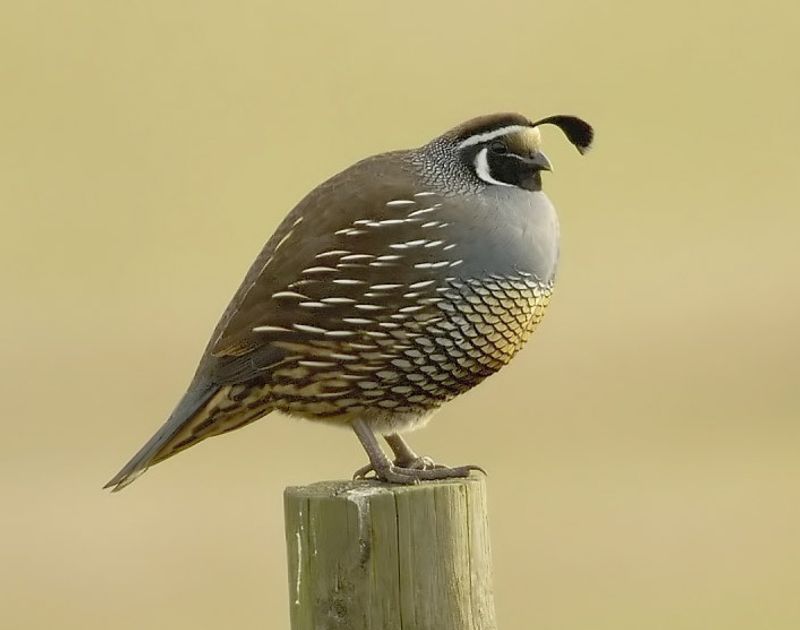
The California quail is a small, ground-dwelling bird native to the New World quail family. It is distinctively recognized by the curved crest on its head, which is composed of six feathers that droop forward.
Male California quail has a black crest, while females have a brown one. The flanks of the bird are brown with white streaks, which further serves to distinguish it from other birds.
In terms of physical characteristics, the California quail is a relatively small bird with a plump body. Its upper parts are grayish-brown in color, while its throat and breast are white. The belly is a reddish-brown color and the tail is finely barred.
The California quail is a ground-dwelling bird that prefers to live in dry, open areas such as grasslands, chaparral, or sagebrush. They are most active during the day, and they tend to form small groups or flocks to feed and forage.
They feed mainly on seeds, but they will also eat insects and other small invertebrates. The California quail is an important species in many parts of its range, as it is an important food source for a variety of predators such as coyotes and raptors.
They are also hunted for sport and food by humans. As a result, they have been introduced to many areas outside their native range. Overall, the California quail is a small, attractive bird that is easily recognized by its distinctive crest and brown flanks with white streaks.
It is an important species in many parts of its range and is hunted for food and sport in some areas.
| Kingdom | Animalia |
| Phylum | Chordata |
| Class | Aves |
| Order | Galliformes |
| Family | Odontophoridae |
| Genus | Callipepla |
| Species | C. californica |
2. Black-crowned Night Heron
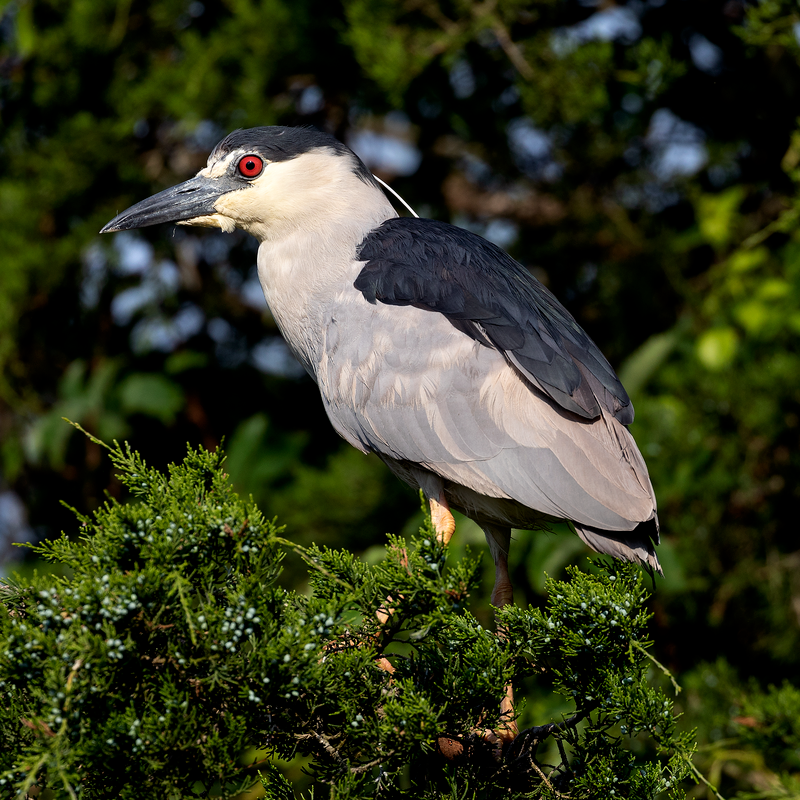
The black-crowned night-heron, or black-capped night-heron, is a medium-sized bird in the heron family. It is a widely distributed species found in parts of Europe, Asia, North America, and South America.
It is known to inhabit wetlands, marshes, lakes, rivers, and other aquatic habitats. The bird is easily identified by its black crown, white facial stripes, and yellow eyes. Its body is grayish-blue in color with a white belly and dark wings.
It has long legs and a short tail. The night heron is a solitary bird, but can often be seen in large groups when roosting or foraging for food. Its diet consists of small fish, amphibians, crustaceans, and insects.
It hunts by standing still in the water and waiting for prey to pass by. It is also known to scavenge for food or steal food from other birds. The black-crowned night heron is a common sight in its range but is threatened by habitat loss, pollution, and hunting.
Its populations are declining in some areas, and the species is listed as vulnerable by the International Union for Conservation of Nature (IUCN). Despite its decline, the bird is still found in many parts of the world, providing a valuable source of food for local communities.
| Kingdom | Animalia |
| Phylum | Chordata |
| Class | Aves |
| Order | Pelecaniformes |
| Family | Ardeidae |
| Genus | Nycticorax |
| Species | N. nycticorax |
3. Brown Pelican
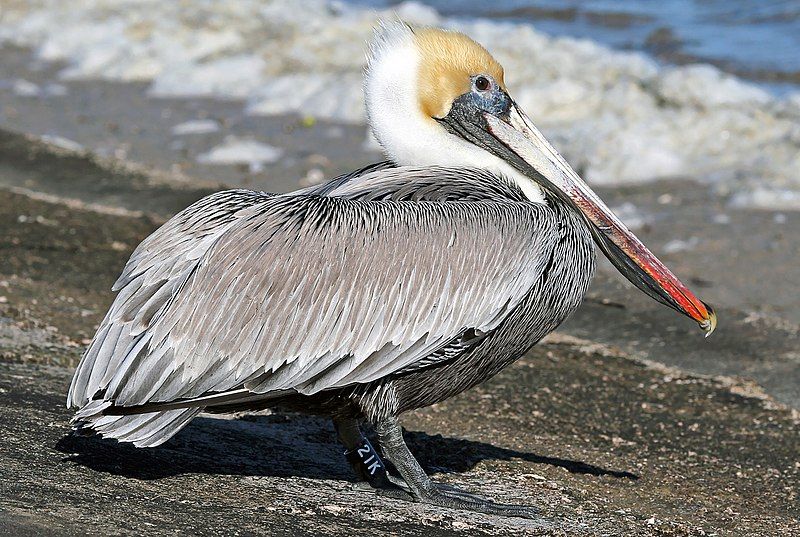
The brown pelican is a large aquatic bird that belongs to the Pelecanidae family. It is one of the three pelican species that can be found in the Americas and is also one of the two species that are known to feed by diving into the water.
This bird has distinctive features, such as a large bill, long wingspan, and brownish-gray feathers. Its bill is particularly distinctive, as it has a pouch-like structure at the base that it uses for catching and storing fish.
The brown pelican is an expert diver, and it can dive up to 20 meters deep in search of prey. It typically hunts alone or in small flocks, and it feeds on fish, crustaceans, mollusks, and other aquatic invertebrates.
It can be found near coasts and in inland wetlands, and it has an impressive wingspan of up to 2.7 meters. The brown pelican is an iconic species of the Americas and is an important part of the region’s wildlife.
| Kingdom | Animalia |
| Phylum | Chordata |
| Class | Aves |
| Order | Pelecaniformes |
| Family | Pelecanidae |
| Genus | Pelecanus |
| Species | P. occidentalis |
4. California Gull
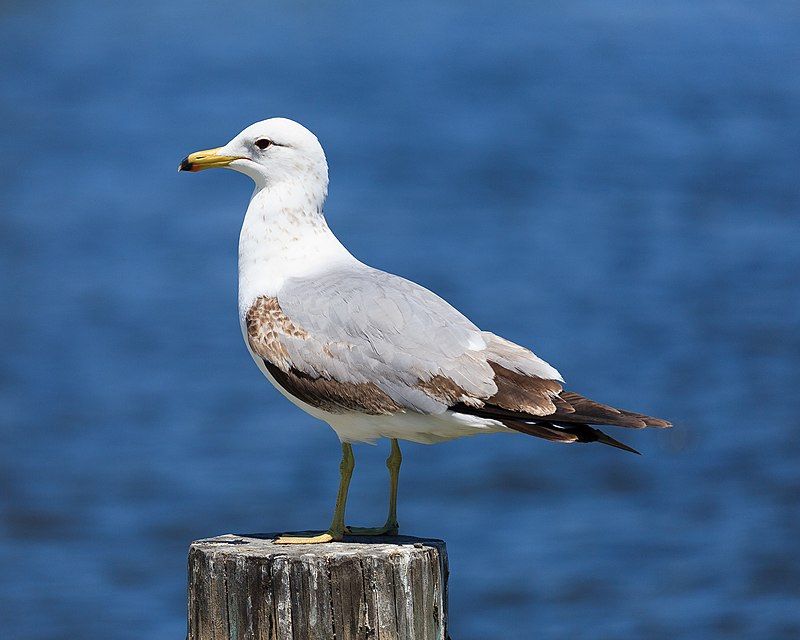
The California gull is a species of gull that is native to the western coast of North America. It is a medium-sized gull, usually smaller than the herring gull but larger than the ring-billed gull.
This species of gull is found not only in California, but in other states along the western coast of the US, as well as some inland areas. The California gull is easily identifiable due to its bright yellow bill, which has a prominent black ring near the tip.
This bill is a key feature of the species and helps to distinguish it from other gulls. Its body is mostly white, with grey wings and a black head. Its legs are yellow, and its eyes are brown.
The California gull is an essential part of the ecosystem along the western coast of North America. It is a scavenger, and its diet includes fish, insects, and other small animals. It is also an effective predator, preying on other birds, eggs, and even small mammals.
This species of gull is also known for its helpful behavior; it will often eat insects that are harmful to crops, providing a beneficial service to farmers. Overall, the California gull is a valuable species in the western US.
It’s bright yellow bill and black ring, combined with its wide range and helpful behavior, make it an essential part of the coastal ecosystem.
| Kingdom | Animalia |
| Phylum | Chordata |
| Class | Aves |
| Order | Charadriiformes |
| Family | Laridae |
| Genus | Larus |
| Species | L. californicus |
5. Anna’s Hummingbird
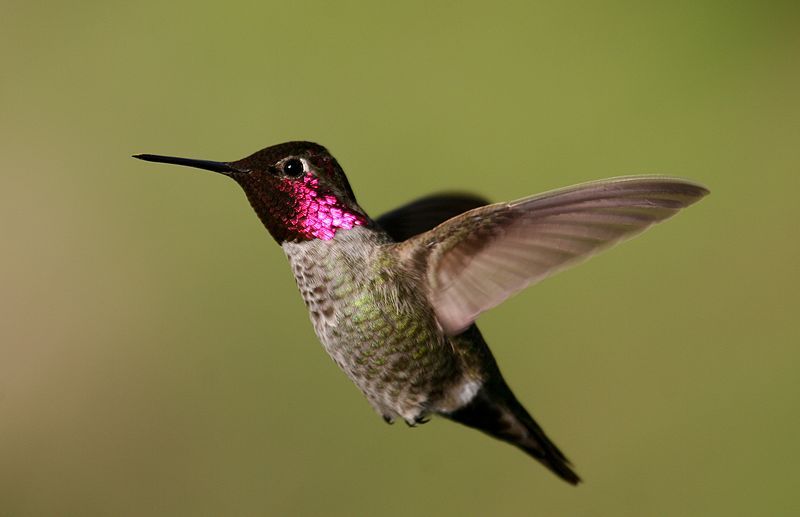
Anna’s hummingbird is a species of hummingbird found in North America. It was named after Anna Masséna, Duchess of Rivoli, who was a naturalist and ornithologist.
The species is native to western coastal regions of North America, including northern Baja California and Southern California.
In the early 20th century, it was found to be breeding only in these two regions. Anna’s hummingbirds are some of the smallest birds in North America, measuring only up to 3.5 inches in length.
They have iridescent green feathers on their backs and tails, and their throats are a brilliant magenta-red color. Anna’s hummingbirds are so named because of the characteristic humming sound they make when in flight.
The sound is created by their wings, which beat at an incredibly high speed. Anna’s hummingbirds are nectar feeders, and they are especially attracted to the nectar of certain flowers.
They have a wide variety, including those found in gardens, such as honeysuckle, larkspur, and columbines.
They also feed on insects, such as aphids and spiders, which they find in trees and shrubs. Anna’s hummingbirds are quite territorial, and they will defend their territories fiercely.
They will typically chase away any other hummingbirds that enter their area in order to protect their food supply and nesting sites.
They are also quite vocal, often vocalizing during their territorial displays. Anna’s hummingbirds are an integral part of the North American ecosystem, and they play an important role in pollination.
They are also a popular sight for bird watchers, as they can be seen flying around gardens and parks.
| Kingdom | Animalia |
| Phylum | Chordata |
| Class | Aves |
| Clade | Strisores |
| Order | Apodiformes |
| Family | Trochilidae |
| Genus | Calypte |
| Species | C. anna |
6. California Scrub Jay
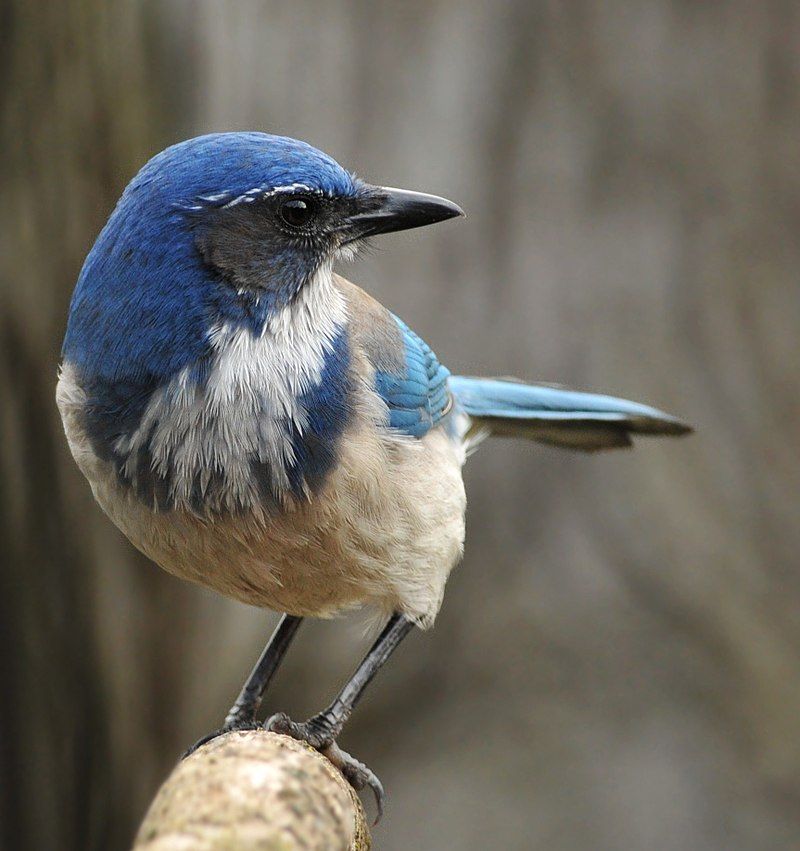
The California scrub jay is a species of bird found in the western part of North America. It is native to southern British Columbia, California, western Nevada near Reno, and west of the Sierra Nevada Mountains.
This species of bird is known for its bright blue feathers and grey coloring. Its diet consists of fruits, insects, and other small animals. It is also known to store food near its nest for later use. The California scrub jay is an active and intelligent bird.
It is known to be social and will often form flocks with other jays in their area.
They are also known to be very protective of their family and territory and will aggressively defend it against other birds of the same species. The California scrub jay is an important species to the ecology of the western North American region.
They help to disperse seeds from the fruits they eat and help to keep the ecological balance in the area.
They are also a great food source for other animals in their area, providing a vital link in the food chain.The California scrub jay is an important species and is listed as a species of Least Concern by the International Union for Conservation of Nature.
Despite this, their numbers are in decline due to habitat destruction and fragmentation. Conservation efforts are needed to ensure the long-term survival of the species.
| Kingdom | Animalia |
| Phylum | Chordata |
| Class | Aves |
| Order | Passeriformes |
| Family | Corvidae |
| Genus | Aphelocoma |
| Species | A. californica |
7. American Robin
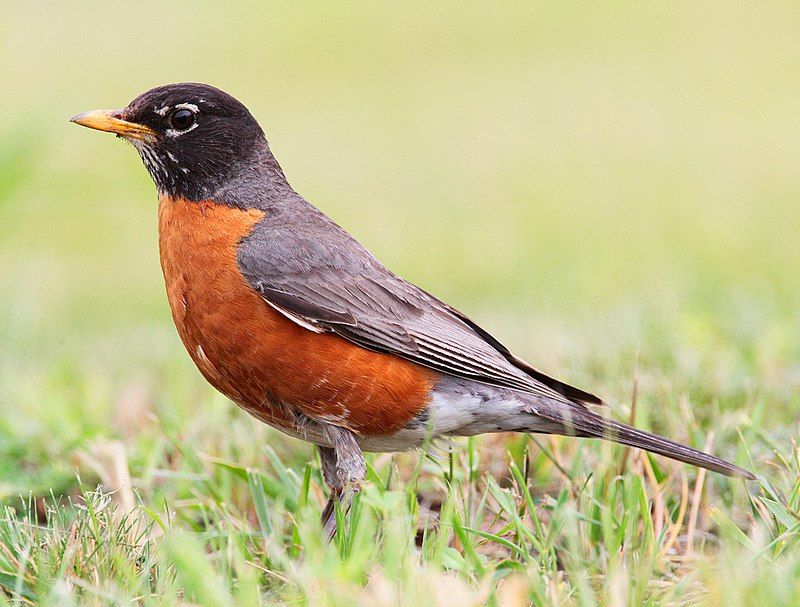
The American robin is a type of migratory bird that belongs to the true thrush genus and the wider thrush family, known as Turdidae. It was named after the European robin due to its reddish-orange breast, although the two species are not closely related.
The European robin actually is a member of the Old World flycatcher family. The American robin is a familiar sight in many places in the United States, with its distinctive reddish-orange chest and its friendly, cheery song.
It can be found in forests, parks, and even in urban areas. These birds typically migrate in the winter, heading south for warmer climates. They usually return to the same areas they left in the spring.
The American robin is an important part of the environment, as it plays an important role in the food chain. It feeds on worms, insects, and fruits, which helps to control insect populations.
It also helps to disperse the seeds of many plants, helping to promote healthy ecosystems. The American robin is an iconic symbol of spring, with its bright color and cheerful song. Its presence is a reminder of the beauty and joy of nature, and its importance in our lives.
| Kingdom | Animalia |
| Phylum | Chordata |
| Class | Aves |
| Order | Passeriformes |
| Family | Turdidae |
| Genus | Turdus |
| Species | T. migratorius |
8. Bald Eagle
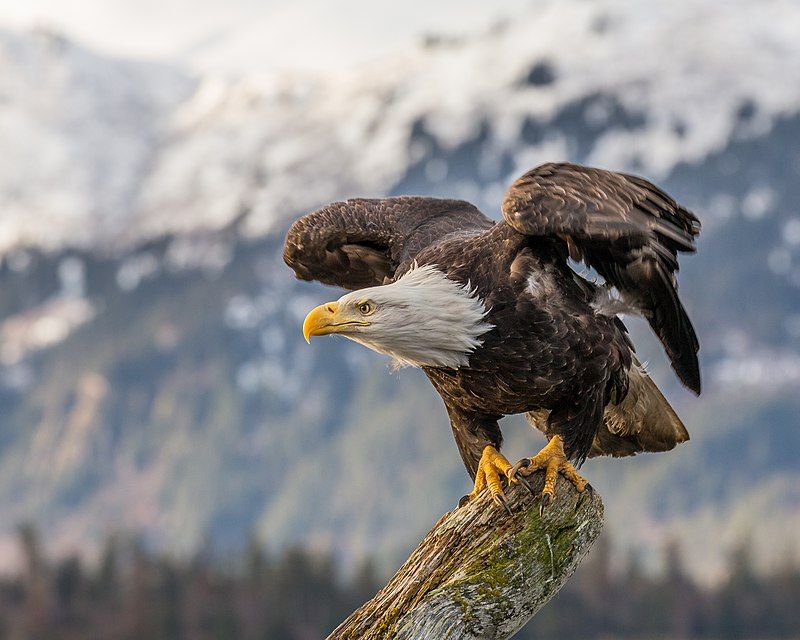
The bald eagle is a majestic bird of prey native to North America. It is a species of sea eagle and is one of two known sub-species. The bald eagle is closely related to the white-tailed eagle, which inhabits the same environment as the bald eagle in the Palearctic.
The bald eagle has a wide wingspan and can soar to great heights with ease, making it an impressive bird to witness in its natural habitat. The bald eagle is an iconic symbol of the United States of America and is featured prominently on the nation’s currency.
It is also a protected species, due to its status as a national symbol and its declining population in recent years. The bald eagle is a beautiful and fascinating creature and is worth protecting so that future generations can enjoy its beauty.
| Kingdom | Animalia |
| Phylum | Chordata |
| Class | Aves |
| Order | Accipitriformes |
| Family | Accipitridae |
| Genus | Haliaeetus |
| Species | H. leucocephalus |
9. California Thrasher
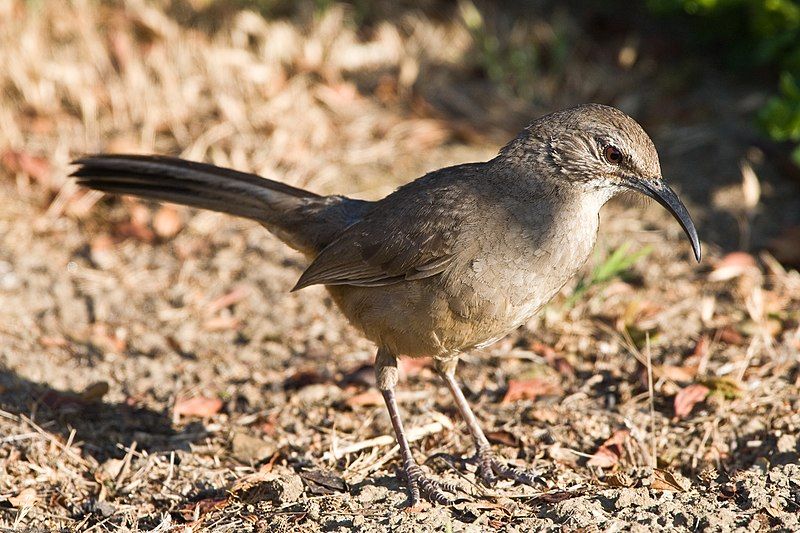
The California thrasher is a member of the Mimidae family, commonly known as “mockingbirds”. It is native to California and Baja California, and primarily inhabits chaparral habitats. The California thrasher is the only member of the genus Toxostoma found in its range.
It is a large bird with a length of 21–30 cm and a wingspan of 32–41 cm. Its plumage is a greyish-brown color with a distinguishing white eye-ring. It has a long, curved bill and a powerful, undulating flight. Its diet consists of insects, seeds, and berries.
It is an active and noisy bird, known for its melodious song, which consists of several notes in a row. It is a solitary bird, typically found alone or in pairs.
| Kingdom | Animalia |
| Phylum | Chordata |
| Class | Aves |
| Order | Passeriformes |
| Family | Mimidae |
| Genus | Toxostoma |
| Species | T. redivivum |
10. Band-tailed Pigeon
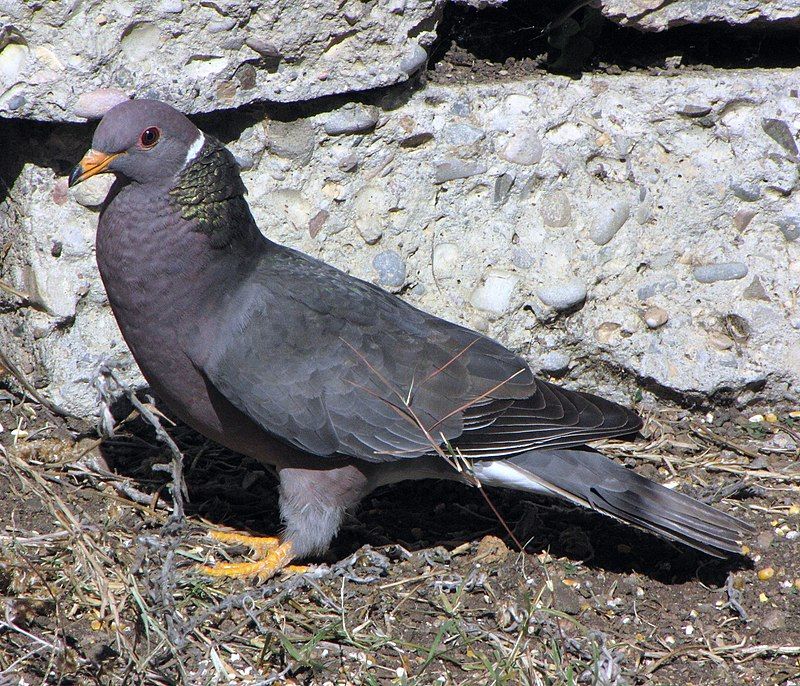
The Band-tailed Pigeon is a species of pigeon that is native to the Americas. It is a medium-sized bird, with a body length of about 16 to 22 inches. Its wingspan is typically between 24 and 28 inches.
The bird’s plumage is a mottled gray-brown, with dark barring on the back and wings. The tail feathers are a distinctive feature, being black with a white tip.
The bill is dark grey and the legs are pinkish-red. The Band-tailed Pigeon is typically found in open woodlands, mountain forests, and shrublands. It is also seen in fields and along roadsides in some areas. It prefers to feed on the ground, often in flocks.
Its diet mainly consists of seeds, berries, and fruits. The Band-tailed Pigeon is a migratory species, with most birds breeding in western and central North America and then migrating to the south for winter.
It is a common sight in many parts of its range, and its population is not considered to be at risk. The species is protected under the Migratory Bird Treaty Act in the United States.
| Kingdom | Animalia |
| Phylum | Chordata |
| Class | Aves |
| Order | Columbiformes |
| Family | Columbidae |
| Genus | Patagioenas |
| Species | P. fasciata |
11. American Goldfinch
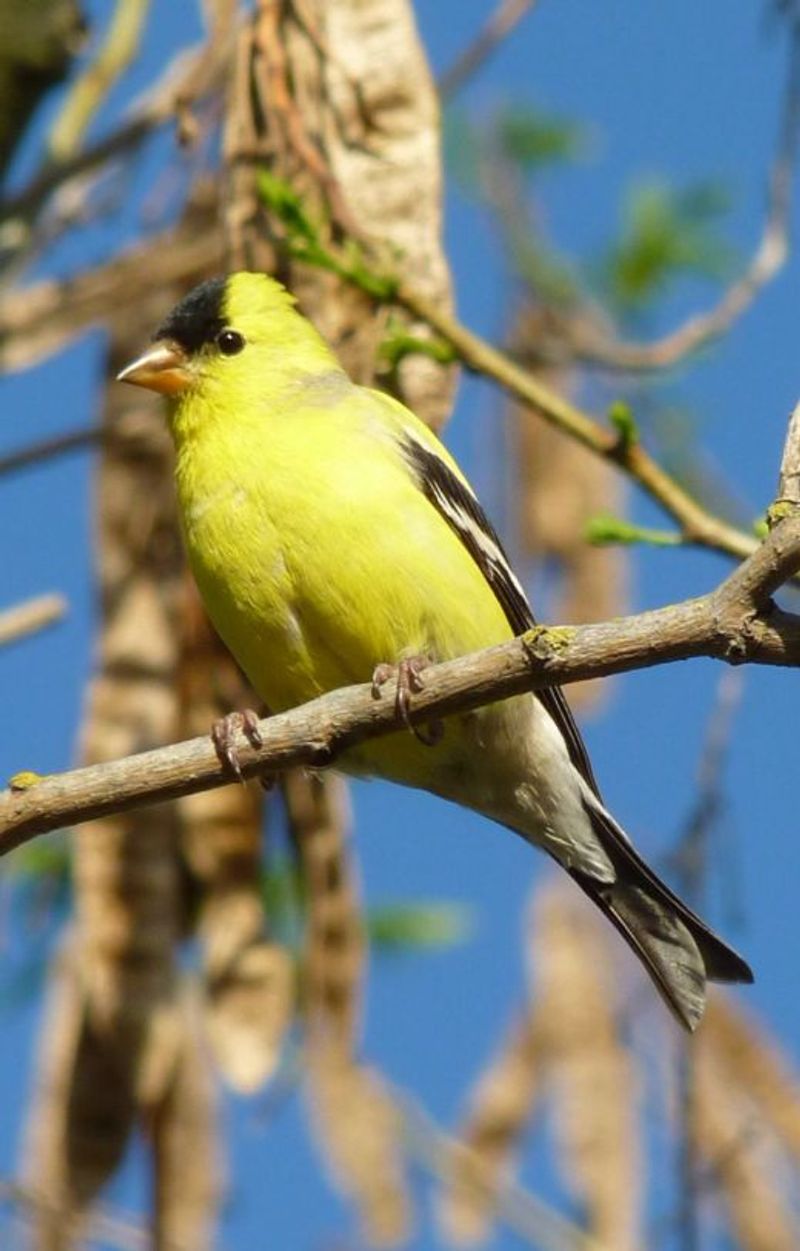
The American goldfinch is a small bird that inhabits North America. It belongs to the finch family and is known for its migratory patterns. During the breeding season, it can be found in a wide range ranging from mid-Alberta to North Carolina.
During the winter season, it migrates south and can be spotted just south of the Canada-United States border, all the way down to Mexico. The American goldfinch is a unique species due to its migratory behavior.
While some birds may migrate over short distances within a specific region, the American goldfinch migrates over a much greater distance, spanning the entire North American continent.
This is likely a result of the changing climates and food sources that the bird needs throughout the year. The American goldfinch is an important part of the North American ecosystem. It helps to maintain the balance of the food chain by consuming various insects and seeds.
In turn, its presence provides food for larger predators. By providing a source of food, the American goldfinch helps to create a healthy ecosystem for other animals. Overall, the American goldfinch is an iconic species of North American bird.
Its migratory behavior is unique and helps to maintain the balance of the food chain in the region. Its presence is an important part of the North American ecosystem and should be preserved and protected for future generations.
| Kingdom | Animalia |
| Phylum | Chordata |
| Class | Aves |
| Order | Passeriformes |
| Family | Fringillidae |
| Genus | Spinus |
| Species | S. tristis |
12. Black Phoebe
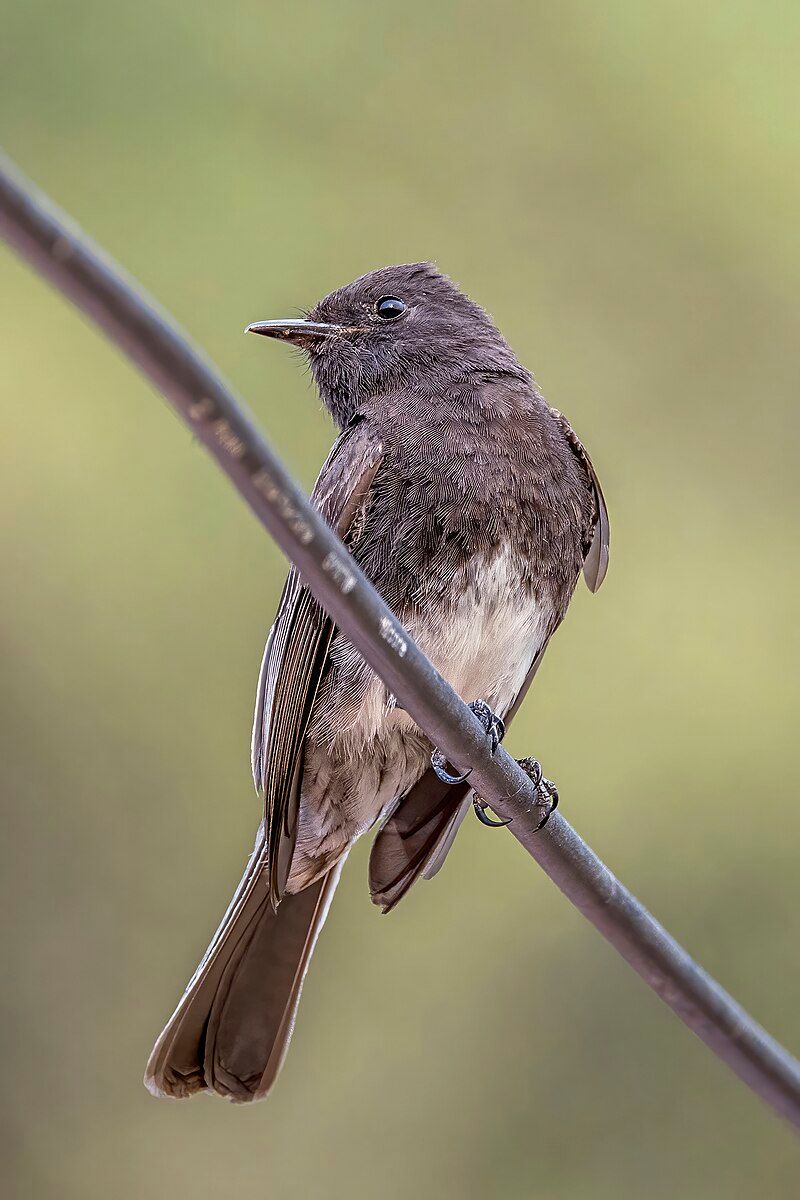
The black phoebe is a member of the tyrant-flycatcher family, which consists of birds that typically have distinct black and white coloring.
This species is native to the western United States, stretching from southwest Oregon and California southward through Central and South America.
While some members of the same genus migrate seasonally, the black phoebe migrates relatively little, though its northern populations may move south for the winter. It is found year-round throughout most of its range.
This species is easily recognizable by its distinctive black and white markings, as well as its loud, repetitive call. It is often seen perched on the edge of a branch, ready to swoop down and catch insects.
It prefers open, wooded areas near water, and often nests near rivers or lakes.
| Kingdom | Animalia |
| Phylum | Chordata |
| Class | Aves |
| Order | Passeriformes |
| Family | Tyrannidae |
| Genus | Sayornis |
| Species | S. nigricans |
13. Acorn Woodpecker
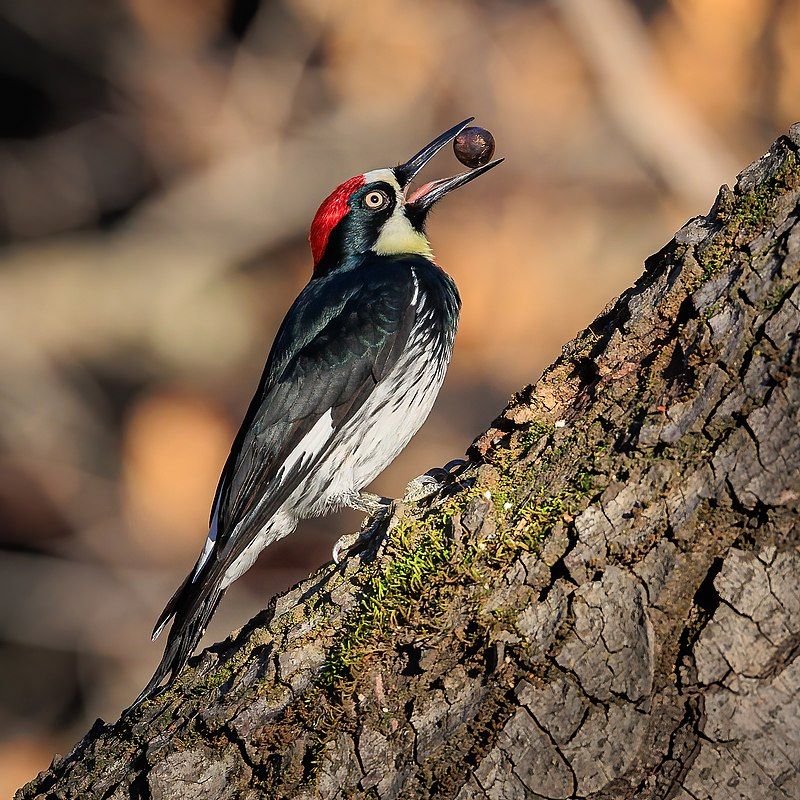
The Acorn Woodpecker is a species of bird that is found in western North America. It is a medium-sized woodpecker, measuring 21 cm in length and weighing an average of 85 g. This species of woodpecker has a black body with white patches on its wings and a distinctive red crown.
Its bill is long and slender, allowing it to reach deep into the bark of trees to feed on insects and grubs. The Acorn Woodpecker is known for its habit of hoarding acorns, which it stores in the crevices of trees or in cavities it has excavated itself.
This habit of storing food enables it to survive during times of food scarcity. The Acorn Woodpecker also feeds on fruits, seeds, and nuts. It is an important seed disperser, helping to spread the seeds of many native trees and shrubs across the landscape.
| Kingdom | Animalia |
| Phylum | Chordata |
| Class | Aves |
| Order | Piciformes |
| Family | Picidae |
| Genus | Melanerpes |
| Species | M. formicivorus |
14. Western Gull
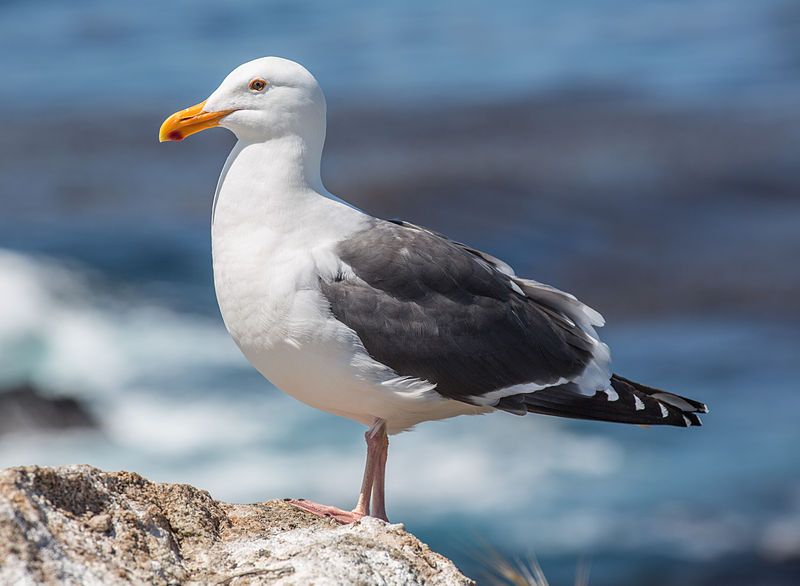
The western gull is a species of large white-headed seabird found on the coast of North America and the Pacific Ocean. Its range stretches from British Columbia, Canada, all the way down to Baja California, Mexico.
This species was once thought to be the same species as the yellow-footed gull which is found in the Gulf of California. However, recent research has identified distinct differences between the two species, such as the western gull having a wider bill and paler eyes.
The western gull has a wingspan of up to 1.5 meters and is mainly white with grayish-brown wings and a yellowish bill. It can be found in areas of rocky shorelines, mudflats, and even in landfills where it feeds on carrion, fish, and crabs.
The western gull is an important part of the ecological balance of the North American coast and is considered to be a species of least concern by the International Union for Conservation of Nature.
| Kingdom | Animalia |
| Phylum | Chordata |
| Class | Aves |
| Order | Charadriiformes |
| Family | Laridae |
| Genus | Larus |
| Species | L. occidentalis |
Conclusion
Ventura County is a great place to observe birds and their habitats. It is a great place to take a nature walk, observe birds in their natural habitats, and observe the many different species of birds that inhabit this area.
Ventura County has many protected areas for birds, making it a great place to observe and appreciate nature.